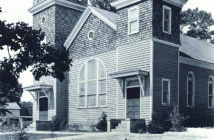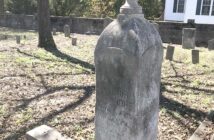Think nearly 150 years ago and it is May in the little Village of Chester. A fierce battle is raging outside a little yellow house known simply then as the Winfree House. The woman who lives there approaches Colonel William Fowler of the Union troops with a fierce glare in her eyes, walked to the lane fence and, in a tone of voice indicating she was both angry and excited, ordered him to take the guns away; and tells him to leave. The sound and blasts from the cannon are breaking the glass panes in the windows of her home. Bullets are flying about. He suggests that she go to her cellar for safety. She persistently refuses and is highly upset. All his pleas would not lodge her from his cannons. Imagine this spunky woman telling a Union officer to leave and take his cannon with him? Even the Confederates couldn’t do that. And only after the Union officer ran out of ammunition did he leave.
Today, the “Yellow House” is white and very much the same as it was in 1864. The land mass has shrunk but the house is quite intact with a few modifications. It once served as a school for young southern girls who left their initials scratched in the window panes, all adding to its rich history. Even the bees once made their home in a bullet hole in the side of the house.
In the Battle for Chester Station, the Winfree house stood a short distance from the road into Chester and throughout the battle, it intentionally sustained damage to the home by the Confederates, especially around the chimney and quite a few bullet holes. The intent was to dislodge the Union sharpshooters. Confederates tried twice to break the Union line. The 9th and 38th Virginia Infantry charged down the turnpike (Jefferson Davis Highway), and part of the 169th New York Infantry gave way, abandoning that portion of the line and one cannon. The 14th, 53rd, and 57th Virginia Infantry converged from three directions to make the second assault on the Federals around the Winfree House. As the defenders’ ammunition dwindled, desperately neededUnion infantry and artillery reinforcements arrived just in time, deploying directly into the Winfree House lane and along the turnpike and checking the Virginians’ advance. Outnumbered, the beleaguered Southerners began to give ground. Adding to the confusion, Federal artillery shells ignited the woods early in the action, and the smoke and flames driving into the Confederate lines which blinded them and deranged the precision of movements. Both sides fought gallantly and fiercely including hand-to-hand combat. The Federals soon retired to their Bermuda Hundred lines.
Two Confederate brigades had faced an Ohio regiment, which was pushed back despite arrival of reinforcements from Hawley’s brigade that arrived on the field. The growing Union reinforcements started to outnumber them, and the Confederates were compelled to retire to Drewry’s Bluff, while at the same time the Federals withdrew east to Bermuda Hundred. The result was a draw with neither side having surrendered, been defeated, or gained any ground. The Union forces succeeded in destroying some railroad track, and the Confederate forces succeeded in stopping them from doing any more damage. In the drawing the 1st Connecticut Light Battery is posted near the Winfree House to repulse Confederate forces.
Confederate attacks here in May 1864 failed to dislodge Union infantry stationed along the Southern communication and supply line lines from Richmond to Petersburg. Although Union forces held the battlefield, they soon withdrew to Bermuda Hundred and were “bottled up” there. The Action at Chester Station was a relatively minor battle of the Bermuda Hundred Campaign and ended indecisively.
The Winfree home was saved and soon repaired. Throughout its history the house has gone through a few owners and very well maintained. Around 1880 a Mr. Whiteside from Pennsylvania who had fought for the Union side in this area during the War, came to Chester and settled on this 300 acre farm paying $2,500. He left the place to his daughters and the land was subsequently divided. P.W. Wing bought it in 1906 and put plumbing in the house. Supposedly this house had the first bathroom in Chester. It does still have a very comfortable claw footed tub. Standing today adjacent to West Hundred Road and near Sunset Memorial Cemetery, you can just barely see the house from the road.
A proud and fascinating history surrounds the Chester home today. It is a fascinating historical story and that brave woman from 150 years ago cannot tell us more, however, there is a very nice tour guide book vailable. A copy can be obtained in the Magnolia Grange House Museum gift shop or from the Chesterfield Historical Society of Virginia. The Bermuda Hundred Campaign was fought entirely in Chesterfield County, Va. and is the only campaign in the Civil War fought entirely in one county. Chester village has a rich history. The present owner of the “Yellow House,” Sara Gibson, recently hosted the Chesterfield Historical Society’s quarterly meeting and offered a tour of this historic and fascinating home. Looking over the site, one could picture the Union and Confederate soldiers in battle with one another and a spunky little Connecticut woman, the bravest of all, demanding they leave.


